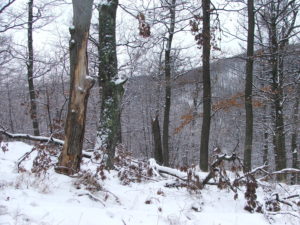General description of project area
Name of the project area: Felsőtárkányi Barát-erdő
Surface area (ha): 99.030
EU protection status SPA: NATURA 2000 Code HUBN10001
EU protection status SCI: NATURA 2000 Code HUBN20002
Other protection status according to national or regional legislation: National Park
The main uses of the project site: The main land uses: Nature conservation 100%
The ownership status: Sate property 100%

Scientific description of project area
The project area is located in the South-West-Bükk minor landscape mainly on non-karst. The area is dominated by 91G0*Pannonic woods with Quercus petraea and Carpinus betulus forests (78%), which is mixed with 91M0 Pannonian-Balkanic turkey oak –sessile oak forests (8%), 91H0 *Pannonian woods with Quercus pubescens forest’s area (2%), and 9180* Tilio-Acerion forests of slopes, screes and ravines (1%).
The most important plant species are the Galanthus nivalis, Pulsatilla grandis and Thlaspi jankae of the area.
- Animals of the area:
- Mammals: Barbastella barbastellus, Dryomys nitedula, Eptesicus serotinus, Glis glis, Miniopterus
schreibersii, Nyctalus noctula, Pipistrellus pygmaeus, Pipistrellus pipistrellus. - Birds: Aquila pomarina, Bubo bubo, Dryocopus martius, Dendrocopos leucotos, Emberiza cia, Ficedula
albicollis, Picus canus, and Strix aluco. - Beetles: Cerambyx cerdo, Dicerca berolinensis, Eurythyrea quercus, and Lucanus cervus
- Butterflies: Dioszeghyana schmidtii
Importance of the project area for biodiversity and/or for the conservation of the species /habitat types targeted at regional, national and EU level
The site includes thermophilous oak forests; due to the petrographical differences and marked relief
variability significantly represented in the area, ensuring a peculiar flora and fauna. Significant species enrichment has taken place in areas where the geological, geomorphological and microclimatic diversity was coupled with an extensive antropogenic impact, favourably affecting the settlement of species and the stability of populations. The different oak forest stands (91G0, 91H0, 91M0,) are very important habitats of several strictly protected species listed in the scientific description part, hence a proper nature conservation management of the oak forests is required. The stand structure, composition, mixture rate and dead wood of Pannonic woods with Quercus petraea and Carpinus betulus, Pannonian woods with Quercus pubescens and Pannonian-Balkanic turkey oak – sessile oak forests of the area, can be improved by proper nature conservation management. These forests and the presence of Sub-Pannonic steppic grasslands makes the area important from biodiversity and EU point of view. The naturalness and biological diversity of the area can be relatively quickly improved by a proper nature conservation management.
Flagship species in project area
Lucanus cervus, Ficedula albicollis, Glis glis